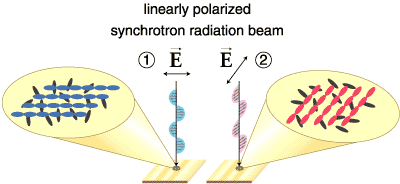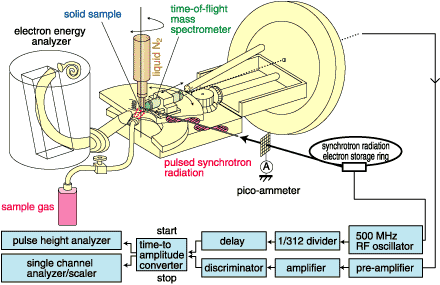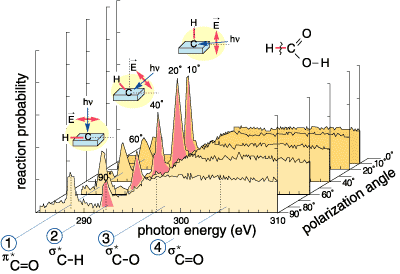We have studied X-ray induced chemical reactions occurring on surfaces, using the energy tunability or polarized property which is one of the most powerful advantages of synchrotron radiation.
Let us consider how a substance absorbs X-ray photons when it is irradiated by X-rays. When the photon energy is tuned exactly to the difference between the energy levels of the occupied and unoccupied molecular orbitals (MOs) of the substance, the photoabsorption probability drastically increases. This phenomenon is called "Resonant absorption" or "Resonant excitation". In these resonant processes, an electron is promoted to an unoccupied MO that has a specific direction. Thus, when a molecular axis is orientated with the direction of the electric field (E) vector of the light, the photoabsorption cross section reaches a maximum. On the basis of this, we have proposed an experimental plan: one can selectively activate molecules with the desired orientation even if molecules are randomly oriented and therefore carry out specific chemical reactions (Fig. 4-15(a)).
To perform this experiment, we have newly designed and constructed the experimental system shown in Fig. 4-15(b). This instrument is unique because it uses pulsed X-rays which impinge on solids and trigger chemical reactions, as well as incorporating a time-of-flight mass-spectrometer that can rotate in the vacuum chamber and detect reaction products with various emission angles. Figure 4-16 shows an example of what we have recently obtained by applying this instrument, which are data on solid formic acid. You can see that the excitation of the C-H bond which is perpendicular to the surface shows higher C-H dissociation probabilities than that of the parallel one. This demonstrates that it is possible to induce a chemical reaction with the desired molecular orientation, and also that chemical reaction pathways differ depending on the bond direction on the surface. |


